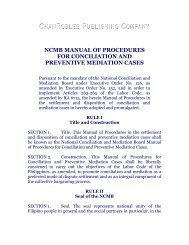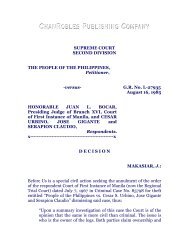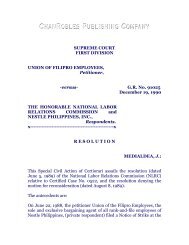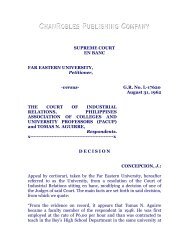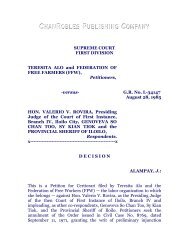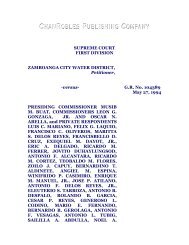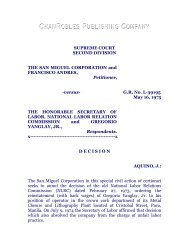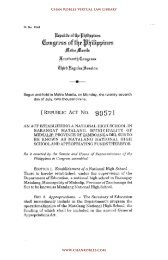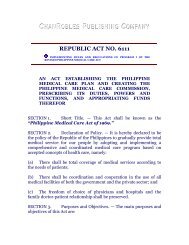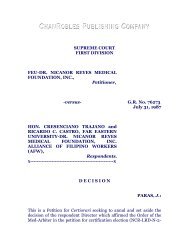IBM Philippines, Inc. vs. NLRC - Chan Robles and Associates Law ...
IBM Philippines, Inc. vs. NLRC - Chan Robles and Associates Law ...
IBM Philippines, Inc. vs. NLRC - Chan Robles and Associates Law ...
Create successful ePaper yourself
Turn your PDF publications into a flip-book with our unique Google optimized e-Paper software.
SUPREME COURT<br />
SECOND DIVISION<br />
<strong>IBM</strong> PHILIPPINES, INC., VIRGILIO L.<br />
PEÑA, <strong>and</strong> VICTOR V. REYES,<br />
Petitioners,<br />
-versus- G.R. No. 117221<br />
April 13, 1999<br />
NATIONAL LABOR RELATIONS<br />
COMMISSION <strong>and</strong> ANGEL D. ISRAEL,<br />
Respondents.<br />
x----------------------------------------------------x<br />
D E C I S I O N<br />
MENDOZA, J.:<br />
This is a Petition for Certiorari to set aside the Decision, [1] dated April<br />
15, 1994, of the National Labor Relations Commission (<strong>NLRC</strong>) finding<br />
private respondent to have been illegally dismissed <strong>and</strong> ordering his<br />
reinstatement <strong>and</strong> the payment of his wages from August 1991 until<br />
he is reinstated. chanroblespublishingcompany<br />
Petitioner <strong>IBM</strong> <strong>Philippines</strong>, <strong>Inc</strong>. (<strong>IBM</strong>) is a domestic corporation<br />
engaged in the business of selling computers <strong>and</strong> computer services.<br />
Petitioners Virgilio L. Peña <strong>and</strong> Victor V. Reyes were ranking officers<br />
of <strong>IBM</strong> during the period pertinent to this case.
On April 1, 1975, private respondent Angel D. Israel commenced<br />
employment with <strong>IBM</strong> as Office Products Customer Engineer. For the<br />
next sixteen (16) years, he occupied two other positions in the<br />
company, [2] received numerous awards, [3] <strong>and</strong> represented the<br />
company in various seminars <strong>and</strong> conferences in <strong>and</strong> out of the<br />
company. [4] chanroblespublishingcompany<br />
On February 1, 1990, private respondent was assigned to the team<br />
supervised by petitioner Reyes. chanroblespublishingcompany<br />
On June 27, 1991, petitioner Reyes h<strong>and</strong>ed a letter to private<br />
respondent informing the latter that his employment in the company<br />
was to be terminated effective July 31, 1991 on the ground of habitual<br />
tardiness <strong>and</strong> absenteeism. The letter states, thus: chanroblespublishingcompany<br />
Mr. Angel D. Israel<br />
Present<br />
Dear Angel,<br />
June 27, 1991<br />
This refers to our previous discussion regarding your habitual<br />
absences <strong>and</strong> tardiness the last of which was on June 26, 1991.<br />
Your records will attest to the fact that on several occasions,<br />
your attention has been called to your habitual tardiness <strong>and</strong><br />
non-observance of st<strong>and</strong>ing office procedures regarding<br />
attendance. Despite several opportunities given to you, you<br />
cannot seem to reform your ways <strong>and</strong> attitude on the matter of<br />
attendance. Considering that we are a service-oriented<br />
company, you can appreciate that we cannot allow such a<br />
situation to continue lest we put the best interest of the<br />
Company in jeopardy. chanroblespublishingcompany<br />
Much to our regret, therefore, pleased (sic) be advised that the<br />
Company is terminating your employment effective July 31,<br />
1991.
You are requested to report to Personnel Department at your<br />
earliest convenience for the settlement of any money or benefits<br />
due you. chanroblespublishingcompany<br />
cc: L.L. Abano<br />
Very truly yours,<br />
(Sgd) V. V. REYES<br />
Business Manager<br />
Alleging that his dismissal was without just cause <strong>and</strong> due process,<br />
private respondent filed a complaint with the Arbitration Branch of<br />
the Department of Labor <strong>and</strong> Employment (DOLE) on July 18, 1991.<br />
In his position paper filed on September 6, 1991, he claimed that he<br />
was not given the opportunity to be heard <strong>and</strong> that he was summarily<br />
dismissed from employment based on charges which had not been<br />
duly proven. [5] chanroblespublishingcompany<br />
Petitioners denied private respondent's claims. It was alleged that<br />
several conferences were held by the management with private<br />
respondent because of the latter's unsatisfactory performance in the<br />
company <strong>and</strong> he was given sufficient warning <strong>and</strong> opportunity to<br />
"reform <strong>and</strong> improve his attitude toward attendance," [6] but to their<br />
regret, he never did. It was alleged that private respondent was<br />
constantly told of his poor attendance record <strong>and</strong> inefficiency through<br />
the company's internal electronic mail (e-mail) system. According to<br />
petitioners, this system allows paperless or "telematic" [7]<br />
communication among <strong>IBM</strong> personnel in the company offices here<br />
<strong>and</strong> abroad. An employee is assigned a "User ID" <strong>and</strong> the<br />
corresponding password is provided by the employee himself <strong>and</strong>,<br />
theoretically, known only to him. Employees are then expected to<br />
turn on their computers everyday, "log in" to the system by keying in<br />
their respective IDs <strong>and</strong> passwords in order to access <strong>and</strong> read the<br />
messages sent to <strong>and</strong> stored in the computer system. To reply, an<br />
employee types in or encodes his message-response <strong>and</strong> sends the<br />
same to the intended recipient, also via the computer system. The<br />
system automatically records the time <strong>and</strong> date each message was<br />
sent <strong>and</strong> received, including the identification of the sender <strong>and</strong>
eceiver thereof. All messages are recorded <strong>and</strong> stored in computer<br />
disks. [8] chanroblespublishingcompany<br />
Attached to petitioners' position paper were copies of print-outs of<br />
alleged computer entries/messages sent by petitioner Reyes to private<br />
respondent through <strong>IBM</strong>'s internal computer system. The following is<br />
a summary of the contents of the print-outs which mostly came from<br />
petitioner Reyes' computer: chanroblespublishingcompany<br />
(a) Private respondent was admonished when he would miss<br />
out on meetings with clients <strong>and</strong> failed to attend to<br />
important accounts, such as that of Hella <strong>Philippines</strong>; [9]<br />
(b) Petitioner Reyes conducted consultations with private<br />
respondent concerning the latter's work habits; [10]<br />
(c) A new policy of requiring employees to be at the office at<br />
8:30 a.m. every morning was adopted <strong>and</strong> employees were<br />
no longer allowed to sign out of the office by phone; [11]<br />
(d) Petitioner Reyes would type into his computer the records<br />
of the security guard which reflect private respondent's<br />
daily tardiness <strong>and</strong> frequent absences; [12] chanroblespublishingcompany<br />
(e) Private respondent was admonished when he failed to<br />
respond to instructions from his superiors; [13]<br />
(f) <strong>IBM</strong> Australia, contacted by Hella Australia, once asked<br />
about the reported lack of attention given to Hella<br />
<strong>Philippines</strong>. [14] Private respondent directly answered <strong>IBM</strong><br />
Australia, through telematic memo, <strong>and</strong> reported that Hella<br />
<strong>Philippines</strong> was deferring its computer plan <strong>and</strong> decided to<br />
use micros in the meantime; [15] chanroblespublishingcompany<br />
(g) The said response was denied by Hella Australia which<br />
later made it clear that it would be buying "anything but<br />
<strong>IBM</strong>"; [16] <strong>and</strong><br />
(h) While private respondent showed some improvement after<br />
consultations where he allegedly admitted his
shortcomings, petitioner Reyes reported that he (private<br />
respondent) would eventually slide back to his old ways<br />
despite constant counseling <strong>and</strong> repeated warnings that he<br />
would be terminated if he would not improve his work<br />
habits. [17] chanroblespublishingcompany<br />
Through these computer print-outs calling private respondent's<br />
attention to his alleged tardiness <strong>and</strong> absenteeism, petitioner sought<br />
to prove that private respondent was sufficiently notified of the<br />
charges against him <strong>and</strong> was guilty thereof because of his failure to<br />
deny the said charges. chanroblespublishingcompany<br />
On March 13, 1992, the labor arbiter rendered a decision finding<br />
private respondent to have been terminated for cause <strong>and</strong> accordingly<br />
dismissing the complaint. Considering, however, the ground for<br />
termination as well as private respondent's long record of service to<br />
the company, the arbiter ordered the award of separation pay at the<br />
rate equivalent to one-half (½) month salary for every year of service.<br />
The dispositive portion of the decision reads — chanroblespublishingcompany<br />
WHEREFORE, judgment is hereby rendered in this case<br />
declaring respondent <strong>IBM</strong> Phils., <strong>Inc</strong>. not guilty of the charge of<br />
illegal dismissal. However, respondent company is directed to<br />
pay complainant Israel the sum of Two Hundred Forty Eight<br />
Thous<strong>and</strong> (P248,000.00) as separation pay. All other claims<br />
are denied for lack of merit. chanroblespublishingcompany<br />
It appears, however, that prior to the release of the labor<br />
arbiter's decision at 11:21 a.m. on March 26, 1992, private<br />
respondent had filed a "Manifestation And Motion To Admit<br />
Attached New Evidence For The Complainant" which was<br />
received by the Arbitration Branch at 10:58 a.m. of the same<br />
day. The evidence consisted of private respondent's Daily Time<br />
Records (DTRs) for the period June 1, 1990 to August 31, 1990<br />
<strong>and</strong> pay slips for the period January 1990 to June 1991 showing<br />
that private respondent did not incur any unexcused absences,<br />
that he was not late on any day within the period <strong>and</strong> that no<br />
deduction was made from his salary on account of tardiness or<br />
absences. chanroblespublishingcompany
Private respondent appealed to the <strong>NLRC</strong> which, on April 15,<br />
1994, reversed the labor arbiter's decision <strong>and</strong> found private<br />
respondent's dismissal illegal. The <strong>NLRC</strong> ruled: (1) that the<br />
computer print-outs which petitioners presented in evidence to<br />
prove that private respondent's office attendance was poor were<br />
insufficient to show that the latter was guilty of habitual<br />
absences <strong>and</strong> tardiness; <strong>and</strong> (2) that private respondent was not<br />
heard in his defense before the issuance of the final notice of<br />
dismissal. 18 The dispositive portion of the <strong>NLRC</strong>'s decision<br />
reads:<br />
WHEREFORE, the Decision dated March 13, 1992 is<br />
hereby SET ASIDE <strong>and</strong> a new one entered declaring the<br />
dismissal of the complainant as illegal. Respondent (sic)<br />
are hereby ordered to reinstate complainant to his former<br />
position without loss of his seniority rights <strong>and</strong> to pay<br />
backwages starting August 1991 until reinstated at the<br />
rate of P40,516.65 a month including all its benefits <strong>and</strong><br />
bonuses. chanroblespublishingcompany<br />
Presiding Commissioner Edna Bonto-Perez dissented on<br />
the ground she found that petitioners have presented<br />
strong <strong>and</strong> convincing documentary evidence that private<br />
respondent was guilty of habitual tardiness <strong>and</strong> absences.<br />
She was also of the opinion that private respondent was<br />
sufficiently warned before he was actually dismissed. [19]<br />
Petitioners moved for a reconsideration, but their motion was denied<br />
in a resolution, dated July 20, 1994. Hence, this petition for<br />
certiorari. Petitioners contend that — chanroblespublishingcompany<br />
1. THE NATIONAL LABOR RELATIONS COMMISSION<br />
COMMITTED GRAVE ABUSE OF DISCRETION<br />
TANTAMOUNT TO LACK OF JURISDICTION IN<br />
HOLDING THAT NO JUST CAUSE EXISTS NOR WAS<br />
THERE DUE PROCESS OBSERVED IN THE DISMISSAL<br />
OF THE PRIVATE RESPONDENT BECAUSE THE<br />
COMPUTER PRINTOUTS WHICH PROVE JUST CAUSE<br />
AND DUE PROCESS ARE NOT ADMISSIBLE IN<br />
EVIDENCE. chanroblespublishingcompany
2. THE NATIONAL LABOR RELATIONS COMMISSION<br />
COMMITTED GRAVE ABUSE OF DISCRETION<br />
TANTAMOUNT TO LACK OR EXCESS OF ITS<br />
JURISDICTION IN HOLDING THAT EVEN IF THE<br />
COMPUTER PRINTOUTS WERE ADMISSIBLE,<br />
PETITIONER FAILED TO SATISFY DUE PROCESS.<br />
We find petitioners' contention to be without merit.<br />
First. Petitioners argue that the computer print-outs submitted by<br />
them need not be identified or authenticated according to the rules of<br />
procedure in regular courts in order for the same to be admissible in<br />
evidence. They contend that technical rules of evidence do not apply<br />
to administrative/labor cases [20] <strong>and</strong> because of a relaxation of the<br />
rules of evidence, private respondent was in fact allowed by the labor<br />
arbiter to adduce additional evidence even after a decision had been<br />
rendered. [21] chanroblespublishingcompany<br />
It is indeed true that administrative agencies, such as the <strong>NLRC</strong>, are<br />
not bound by the technical rules of procedure <strong>and</strong> evidence in the<br />
adjudication of cases. [22] This was the reason private respondent was<br />
allowed to submit additional evidence even after the case was deemed<br />
submitted for resolution by the labor arbiter. The practice of<br />
admitting additional evidence on appeal in labor cases has been<br />
sanctioned by this Court. [23] chanroblespublishingcompany<br />
However, the liberality of procedure in administrative actions is<br />
subject to limitations imposed by basic requirements of due process.<br />
As this Court said in Ang Tibay <strong>vs</strong>. CIR, [24] the provision for flexibility<br />
in administrative procedure "does not go so far as to justify orders<br />
without a basis in evidence having rational probative value." More<br />
specifically, as held in Uichico <strong>vs</strong>. <strong>NLRC</strong>: [25] chanroblespublishingcompany<br />
It is true that administrative <strong>and</strong> quasi-judicial bodies like the<br />
<strong>NLRC</strong> are not bound by the technical rules of procedure in the<br />
adjudication of cases. However, this procedural rule should not<br />
be construed as a license to disregard certain fundamental<br />
evidentiary rules. While the rules of evidence prevailing in the<br />
courts of law or equity are not controlling in proceedings before
the <strong>NLRC</strong>, the evidence presented before it must at least have a<br />
modicum of admissibility for it to be given some probative<br />
value. The Statement of Profit <strong>and</strong> Losses submitted by Crispa,<br />
<strong>Inc</strong>. to prove its alleged losses, without the accompanying<br />
signature of a certified public accountant or audited by an<br />
independent auditor, are nothing but self-serving documents<br />
which ought to be treated as a mere scrap of paper devoid of<br />
any probative value. chanroblespublishingcompany<br />
The computer print-outs, which constitute the only evidence of<br />
petitioners, afford no assurance of their authenticity because<br />
they are unsigned. The decisions of this Court, while adhering<br />
to a liberal view in the conduct of proceedings before<br />
administrative agencies, have nonetheless consistently required<br />
some proof of authenticity or reliability as condition for the<br />
admission of documents. chanroblespublishingcompany<br />
In Rizal Workers Union <strong>vs</strong>. Ferrer-Calleja, [26] this Court struck down<br />
the decision of the Director of Labor Relations which was based on an<br />
unsigned <strong>and</strong> unidentified manifesto. It was held: chanroblespublishingcompany<br />
From even a perfunctory assessment, it becomes apparent that<br />
the "evidence" upon which said decision is professedly based<br />
does not come up to that st<strong>and</strong>ard of substantiality.<br />
It is of course also a sound <strong>and</strong> settled rule that administrative<br />
agencies performing quasi-judicial functions are unfettered by<br />
the rigid technicalities of procedure observed in the courts of<br />
law, <strong>and</strong> this so that disputes brought before such bodies may<br />
be resolved in the most expeditious <strong>and</strong> inexpensive manner<br />
possible. But what is involved here transcends mere procedural<br />
technicality <strong>and</strong> concerns the more paramount principles <strong>and</strong><br />
requirements of due process, which may not be sacrificed to<br />
speed or expediency. The clear message of [Article 291 of the<br />
Labor Code] is that even in the disposition of labor cases, due<br />
process must never be subordinated to expediency or dispatch.<br />
Upon this principle, the unidentified documents relied upon by<br />
respondent Director must be seen <strong>and</strong> taken for what they are,<br />
mere inadmissible hearsay. They cannot, by any stretch of
easoning, be deemed substantial evidence of the election<br />
frauds complained of.<br />
chanroblespublishingcompany<br />
Likewise, in the case of EMS Manpower & Placement Services<br />
<strong>vs</strong>. <strong>NLRC</strong>, [27] the employer submitted a photocopy of a telex<br />
which supposedly shows that the employee was guilty of<br />
"serious misconduct" <strong>and</strong> which became the basis of her<br />
dismissal. This Court ruled that the telex, a "single document,<br />
totally uncorroborated <strong>and</strong> easily concocted or fabricated to suit<br />
one's personal interest <strong>and</strong> purpose," [28] was insufficient to<br />
uphold the employer's defense.<br />
In Jarcia Machine Shop <strong>and</strong> Auto Supply, <strong>Inc</strong>. <strong>vs</strong>. <strong>NLRC</strong>, this Court<br />
held as incompetent unsigned daily time records presented to prove<br />
that the employee was neglectful of his duties: chanroblespublishingcompany<br />
Indeed, the DTRs annexed to the present petition would tend to<br />
establish private respondent's neglectful attitude towards his<br />
work duties as shown by repeated <strong>and</strong> habitual absences <strong>and</strong><br />
tardiness <strong>and</strong> propensity for working undertime for the year<br />
1992. But the problem with these DTRs is that they are neither<br />
originals nor certified true copies. They are plain photocopies of<br />
the originals, if the latter do exist. More importantly, they are<br />
not even signed by private respondent nor by any of the<br />
employer's representatives. [29] chanroblespublishingcompany<br />
In the case at bar, a specimen of the computer print-out submitted by<br />
petitioners reads: chanroblespublishingcompany<br />
Date <strong>and</strong> time 10/12/90 09:23:1<br />
From:<br />
To:<br />
SEC:<br />
REYESVV — MNLVM1<br />
ISRAEL — MNLRVM Israel, A.D.<br />
I-<strong>IBM</strong> INTERNAL USE ONLY<br />
Subject:<br />
Angel, have been trying to pin you down for a talk the past<br />
couple of days. Whatever happened to our good discussion 2<br />
weeks ago I thought you would make an effort to come in on
time from then on If you have problems which prevent you<br />
from coming in on time, let me know because I would really like<br />
to help if I can. The sum of all your quotas is less than mine so I<br />
really need all of you pitching in. Kindly take a look at your<br />
proofs in-tray as there are some to do's which are pending. Acts<br />
such as St. Louis U. <strong>and</strong> NEECO should be worth looking into<br />
as they've been inquiring about upgrading their very old boxes.<br />
If you are too tied up for these accounts do let me know so I can<br />
reassign. By Monday morning please. Let's give it that final<br />
push for the branch! chanroblespublishingcompany<br />
Regards from the APPLICATION MNLVM 1 (REYESVV)<br />
SYSTEMS MARKETING group T (832)8192-279<br />
Victor V. Reyes — Marketing Manager<br />
Not one of the 18 print-out copies submitted by petitioners was ever<br />
signed, either by the sender or the receiver. There is thus no<br />
guarantee that the message sent was the same message received. As<br />
the Solicitor General pointed out, the messages were transmitted to<br />
<strong>and</strong> received not by private respondent himself but his computer. [30]<br />
Neither were the print-outs certified or authenticated by any<br />
company official who could properly attest that these came from<br />
<strong>IBM</strong>'s computer system or that the data stored in the system were not<br />
<strong>and</strong>/or could not have been tampered with before the same were<br />
printed out. It is noteworthy that the computer unit <strong>and</strong> system in<br />
which the contents of the print-outs were stored were in the exclusive<br />
possession <strong>and</strong> control of petitioners since after private respondent<br />
was served his termination letter, he had no more access to his<br />
computer. [31] chanroblespublishingcompany<br />
Second. Even if the computer print-outs were admissible, they would<br />
not suffice to show that private respondent's dismissal was justified.<br />
Petitioners' contention is that private respondent was repeatedly<br />
warned through computer messages for coming in late or not<br />
reporting at all to the office during the period May 1990 — June 1991<br />
but he never denied the allegations. Therefore, he must be deemed to<br />
have admitted these allegations. [32] But the burden of proving that the
dismissal was for just cause is on petitioners. They cannot simply rely<br />
on any admission by private respondent implied from his failure to<br />
deny the alleged computer messages to him which he denied he had<br />
ever received. On the other h<strong>and</strong>, private respondent's additional<br />
evidence, consisting of DTRs <strong>and</strong> pay slips, show that he did not incur<br />
unexcused absences or tardiness or that he suffered deduction in pay<br />
on account of such absences or tardiness. Indeed, petitioners could<br />
have easily proven their allegations by presenting private<br />
respondent's DTRs. Since these were in petitioners' possession, their<br />
non-production thereof raises the presumption that if presented they<br />
would be adverse to petitioners. This is precisely what the best<br />
evidence rule guards against. chanroblespublishingcompany<br />
The purpose of the rule requiring the production of the best evidence<br />
is the prevention of fraud, because if a party is in possession of such<br />
evidence <strong>and</strong> withholds it, <strong>and</strong> seeks to substitute inferior evidence in<br />
its place, the presumption naturally arises that the better evidence is<br />
withheld for fraudulent purposes which its production would expose<br />
<strong>and</strong> defeat. [33] chanroblespublishingcompany<br />
Private respondent's DTRs for the period June 1, 1990 — August 30,<br />
1990 [34] show that while his attendance record may not have been<br />
perfect, it was at least satisfactory. The days when private respondent<br />
did not report to the office were credited either as vacation or as sick<br />
leaves. On days when he was away on business trips, his destination<br />
was shown. The DTRs were signed by petitioner Victor Reyes. chanroblespublishingcompany<br />
It is said that the DTRs presented were only for the period when<br />
private respondent's attendance was excellent; he took care not to<br />
submit his DTRs for other months during which he was often late in<br />
coming to office. [35] As the Solicitor General has pointed out, however,<br />
it was precisely during that period of June 1, 1990 — August 30, 1990<br />
when, according to the print-outs submitted by petitioners, private<br />
respondent was often late or absent. chanroblespublishingcompany<br />
Nor is there proof to support petitioners' allegation that it was private<br />
respondent's secretary <strong>and</strong> not him who often signed the attendance<br />
sheet. [36] Indeed, petitioners did not present private respondent's<br />
secretary or, at the very least, attach an affidavit sworn to by her to<br />
prove their allegations <strong>and</strong> thus dispute the DTRs presented by
private respondent. This, notwithst<strong>and</strong>ing ample opportunity to do<br />
so. On the other h<strong>and</strong>, as already stated, the DTRs, showing private<br />
respondent's good attendance, were signed by petitioner Victor Reyes<br />
himself, <strong>and</strong> no good reason has been shown why they cannot be<br />
relied upon in determining private respondent's attendance. chanroblespublishingcompany<br />
Third. Even assuming the charges of habitual tardiness <strong>and</strong><br />
absenteeism were true, such offenses do not warrant private<br />
respondent's dismissal. He has not been shown to have ever<br />
committed any infraction of company rules during his sixteen-year<br />
stint in the company. Although it is alleged that he failed to attend<br />
important client meetings <strong>and</strong> gave false representations to a valued<br />
client to cover his tracks, there is no record finding him guilty of such<br />
offenses. Dismissal has always been regarded as the ultimate<br />
penalty. [37] The fact that lapses in private respondent's attendance<br />
record may have occurred only during his final year in the company,<br />
after a long period of exemplary performance, makes petitioners'<br />
contention dubious. While it is true that long years of service is no<br />
guarantee against dismissal for wrongdoing, [38] at least the<br />
employee's record does provide an index to his work. In case doubt<br />
exists between the evidence presented by the employer <strong>and</strong> that<br />
presented by the employee, the scales of justice must be tilted in favor<br />
of the latter. [39] chanroblespublishingcompany<br />
Fourth. The print-outs likewise failed to show that private respondent<br />
was allowed due process before his dismissal.<br />
The law requires an employer to furnish the employee two written<br />
notices before termination of his employment may be ordered. The<br />
first notice must inform him of the particular acts or omissions for<br />
which his dismissal is sought, the second of the employer's decision to<br />
dismiss the employee after he has been given the opportunity to be<br />
heard <strong>and</strong> defend himself. [40] chanroblespublishingcompany<br />
These requirements were not observed in this case. As noted earlier,<br />
there is no evidence that there was an exchange of communication<br />
between petitioners <strong>and</strong> private respondent regarding the latter's<br />
supposed subst<strong>and</strong>ard performance. Private respondent has<br />
consistently denied, however, that he was ever advised of the charges<br />
hurled against him. The so-called one-on-one consultations or
"personal counselling mentioned in the print-outs between petitioner<br />
Reyes <strong>and</strong> private respondent concerning the latter's work habits do<br />
not satisfy the requirements of due process, as we had occasion to say<br />
in Pono <strong>vs</strong>. <strong>NLRC</strong>. [41] chanroblespublishingcompany<br />
Consultations or conferences may not be a substitute for the actual<br />
holding of a hearing. Every opportunity <strong>and</strong> assistance must be<br />
accorded to the employee by the management to enable him to<br />
prepare adequately for his defense, including legal representation. [42]<br />
In Ruffy <strong>vs</strong>. <strong>NLRC</strong>, [43] this Court held that what would qualify as<br />
sufficient or "ample opportunity," as required by law, would be "every<br />
kind of assistance that management must accord to the employee to<br />
enable him to prepare adequately for his defense." No such<br />
opportunity was given to private respondent in this case. He was<br />
simply served his termination notice without being heard in his<br />
defense. chanroblespublishingcompany<br />
Fifth. Petitioners allege that the <strong>NLRC</strong>, after concluding that the<br />
evidence submitted by them were not properly identified or<br />
authenticated, should have rem<strong>and</strong>ed the case to the arbiter for<br />
"clarificatory" hearing. chanroblespublishingcompany<br />
A formal hearing was not de rigueur. The 1994 Rules of Procedure of<br />
the <strong>NLRC</strong>, §4 provides: chanroblespublishingcompany<br />
Immediately after the submission by the parties of their<br />
position papers/memor<strong>and</strong>um, the Labor Arbiter shall, motu<br />
proprio, determine whether there is a need for a formal trial or<br />
hearing. At this stage, he may, at his discretion <strong>and</strong> for the<br />
purpose of making such determination, ask clarificatory<br />
questions to further elicit facts or information, including but<br />
not limited to the subpoena of relevant documentary evidence,<br />
if any, from any party or witness. chanroblespublishingcompany<br />
As held by the <strong>NLRC</strong>:<br />
Aside from these computer print-outs, respondents have not<br />
presented any other evidence to prove that complainant was<br />
ever called for investigation nor his side heard prior to receipt
of the termination letter dated June 27, 1991. In fact, even if we<br />
consider these computer print-outs, respondents still failed to<br />
satisfy the requirements of procedural due process. . . . In this<br />
particular case, we observe that there is failure on the part of<br />
respondents to prove the existence of a legal cause. The<br />
evidence presented before the Labor Arbiter did not sufficiently<br />
<strong>and</strong> clearly support the allegation of respondents that<br />
complainant committed habitual absences <strong>and</strong> tardiness<br />
resulting into inefficiency. [44] chanroblespublishingcompany<br />
In spite of this finding, petitioners failed to adduce additional<br />
evidence when they moved for a reconsideration of the <strong>NLRC</strong><br />
decision or when they filed the instant petition. Despite the<br />
opportunities afforded them, petitioners failed to substantiate their<br />
allegations. Neither have they shown sufficient reasons to convince<br />
this Court that, if the case were to be rem<strong>and</strong>ed to the arbiter for a<br />
formal hearing, they would be able to present evidence which they<br />
could not have presented during the initial stages of this case. As we<br />
held in Megascope General Services <strong>vs</strong>. <strong>NLRC</strong>: [45] chanroblespublishingcompany<br />
As regards petitioner's contention that a hearing has to be conducted<br />
to fully ventilate the issues in the case, suffice it to state that<br />
nonverbal devices such as written explanations, affidavits, position<br />
papers or other pleadings can establish just as clearly <strong>and</strong> concisely<br />
an aggrieved party's defenses. Petitioner was amply provided with the<br />
opportunity to present evidence that private respondents were not its<br />
employees. Indeed, it was petitioner's failure to present substantial<br />
evidence to buttress its claims that worked to its disadvantage <strong>and</strong><br />
not the absence of a full-blown hearing before the public respondent.<br />
WHEREFORE, the petition is DISMISSED <strong>and</strong> the decision of the<br />
<strong>NLRC</strong>, dated April 15, 1994, is hereby AFFIRMED. chanroblespublishingcompany<br />
SO ORDERED.<br />
Bellosillo, Puno, Quisumbing <strong>and</strong> Buena, JJ., concur.<br />
chanroblespublishingcompany<br />
[1] <strong>NLRC</strong> NCR Case No. 00-01-04250-91; <strong>NLRC</strong> CA No. 003134-92.
[2] Office Products Marketing Representative: July 1, 1977 - December 31, 1982;<br />
Data Processing Marketing Representative: January 1, 1983 - July 31, 1991.<br />
[3] In 1977, he received the Customer Engineering Excellence in Service Award.<br />
He was also a consistent member of the Hundred Percent Club from 1979 to<br />
1990. See <strong>NLRC</strong> Decision, p. 7; Petition, Annex U; Comment-Private<br />
Respondent, p. 4; Rollo, pp. 103, 146. chanroblespublishingcompany<br />
[4] Comment-Private Respondent, pp. 4-5; Rollo, pp. 146-147.<br />
[5] Comment-<strong>NLRC</strong>, pp. 2-4; Rollo; pp. 209-211.<br />
[6] Comment-<strong>NLRC</strong>, p. 4; Rollo, p. 211. chanroblespublishingcompany<br />
[7] The word "telematic" is not yet found in regular English dictionaries.<br />
According to petitioners, it is derived from the French word telematique<br />
which is used in communications to refer to the combination of computers<br />
<strong>and</strong> telecommunications for data processing <strong>and</strong> information. See Note 1,<br />
Petition, p. 43; Rollo, p. 44. chanroblespublishingcompany<br />
[8] Petition, pp. 36-37; Rollo, pp. 37-38.<br />
[9] Petition, Annexes A, I, <strong>and</strong> J; Rollo, pp. 64, 73-74.<br />
[10] Ibid., Annexes B <strong>and</strong> C; Rollo, pp. 65-67.<br />
[11] Id., Annexes H <strong>and</strong> P; Rollo, pp. 72, 81.<br />
[12] Id., Annexes Q <strong>and</strong> Q-1; Rollo, pp. 82-83.<br />
[13] Id., Annexes D, E, F, <strong>and</strong> G; Rollo, pp. 68-71.<br />
[14] Id., Annex K; Rollo, p. 76. chanroblespublishingcompany<br />
[15] Id., Annex L; Rollo, p. 77. chanroblespublishingcompany<br />
[16] Id., Annexes M <strong>and</strong> N; Rollo, pp. 78-79.<br />
[17] Id., Annexes R <strong>and</strong> S; Rollo, pp. 84-85.<br />
[18] <strong>NLRC</strong> Decision, pp. 6-7; Rollo, pp. 102-103.<br />
[19] See Petition, Annex W-1; Rollo, pp. 106-107.<br />
[20] Petition, p. 43; Rollo, p. 44. chanroblespublishingcompany<br />
[21] Reply, p. 4; Rollo, p. 246. chanroblespublishingcompany<br />
[22] LABOR CODE, Art. 221; Jarcia Machine Shop <strong>and</strong> Auto Supply <strong>vs</strong>. <strong>NLRC</strong>,<br />
266 SCRA 97 (1997). chanroblespublishingcompany<br />
[23] Cañete <strong>vs</strong>. <strong>NLRC</strong>, 250 SCRA 259, 266 (1995); Bristol Laboratories<br />
Employees' Association <strong>vs</strong>. <strong>NLRC</strong>, 187 SCRA 118, 121 (1990).<br />
[24] 69 Phil. 635, 643 (1940).<br />
[25] 273 SCRA 35, 44-45 (1997).<br />
[26] 186 SCRA 431 (1990).<br />
[27] 276 SCRA 117 (1997).<br />
[28] Supra, at 121.<br />
[29] 266 SCRA at 104.<br />
[30] Comment-<strong>NLRC</strong>, p. 10; Rollo, p. 217.<br />
[31] Comment, p. 10; Rollo, p. 152. chanroblespublishingcompany<br />
[32] Petition, pp. 45, 47; Rollo, pp. 46, 58.<br />
[33] 7 VICENTE V. FRANCISCO, THE REVISED RULES OF COURT IN THE<br />
PHILIPPINES 121-122 (1973). chanroblespublishingcompany<br />
[34] Comment-Private Respondent, Annexes A to A-3; Rollo, pp. 165-168.<br />
[35] Petition, p. 41; Rollo, p. 42. chanroblespublishingcompany<br />
[36] Petition, p. 14; Rollo, p. 17. chanroblespublishingcompany
[37] Philippine Long Distance Telephone Company <strong>vs</strong>. National Labor Relations<br />
Commission <strong>and</strong> Enrique Gabriel, G.R. No. 106947, February 11, 1999 citing<br />
Pantranco North Express, <strong>Inc</strong>. <strong>vs</strong>. National Labor Relations Commission,<br />
252 SCRA 237, 243 (1996). chanroblespublishingcompany<br />
[38] Philippine Air Lines <strong>vs</strong>. National Labor Relations Commission, 198 SCRA<br />
748, 762 (1991). chanroblespublishingcompany<br />
[39] Triple Eight Integrated Services, <strong>Inc</strong>. <strong>vs</strong>. National Labor Relations<br />
Commission, G.R. No. 129584, December 3, 1998.<br />
[40] Rule XIV, Book V, Omnibus Rules Implementing the Labor Code; National<br />
Service Corporation <strong>vs</strong>. Third Division, <strong>NLRC</strong>; Credo <strong>vs</strong>. <strong>NLRC</strong>, 168 SCRA<br />
122, 128-129 (1998).<br />
[41] 275 SCRA 611 (1997).<br />
[42] Id. at 619. chanroblespublishingcompany<br />
[43] 182 SCRA 365, 369-370 (1990).<br />
[44] Rollo, pp. 100-101, 102. chanroblespublishingcompany<br />
[45] 274 SCRA 147, 155 (1997) (Emphasis added).


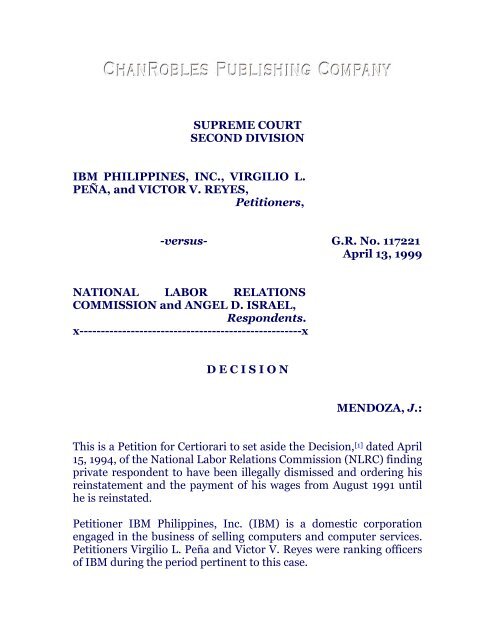
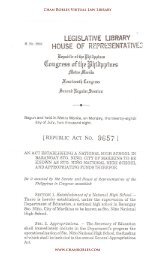
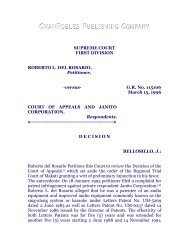
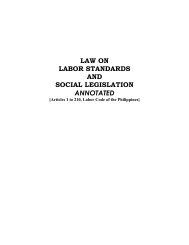
![Aurelio vs. NLRC, (221 SCRA 432 [1993]) - Chan Robles and ...](https://img.yumpu.com/51280528/1/190x245/aurelio-vs-nlrc-221-scra-432-1993-chan-robles-and-.jpg?quality=85)
